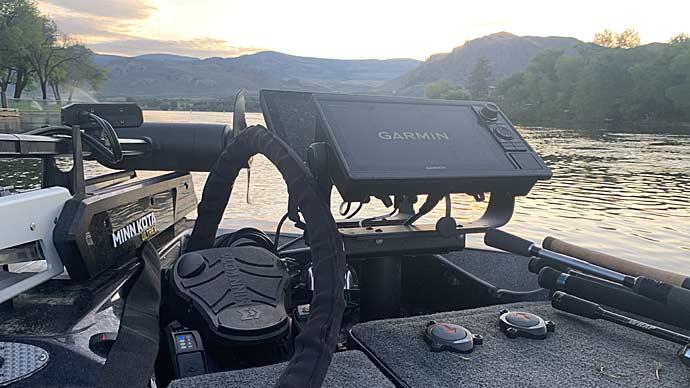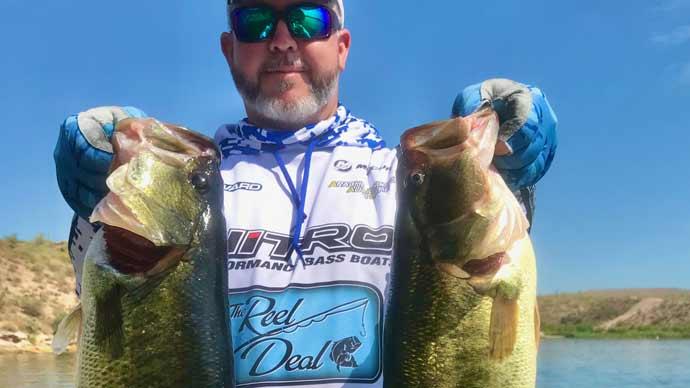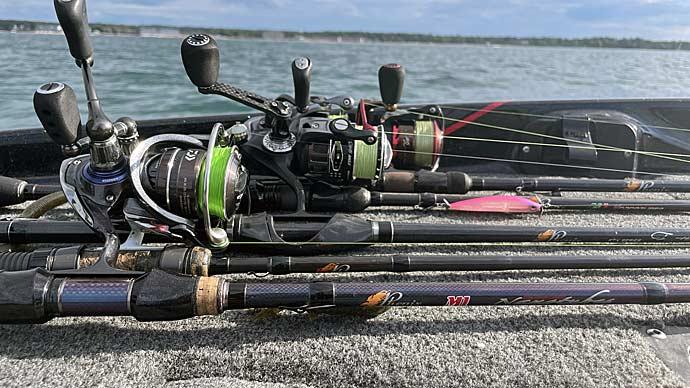
Recreational anglers first got their hands on a fish finder in the late 1950s when Darrell Lowrance introduced the FISH LO-K-TOR. That "Little Green Box,” along with every fish finder designed and built since, has changed bass fishing to some degree. They’ve taken us further into the bass’ world, providing detailed information about depth, bottom contour, fish, water temperature, and location.
The most significant advance in fish finders may be the most recent — forward-facing sonar. FFS, pioneered by Garmin and now offered by other manufacturers, gives anglers a real-time view of what’s happening up to about 100 feet in front of their boat. Fish and baitfish swim across the screen; they’re no longer locked in the past as static arches or blobs. And that story plays out in whichever direction you point its transducer, typically mounted on a trolling motor or, in the case of kayaks, a specially designed mount.
Seeing bass in real-time lets you watch them react to each other, baitfish, and your presence. You also see them interact with your lure, whether ignoring, chasing, or eating it. So, lures that can stay with the bass you’re watching or show up better on FFS make you a more efficient angler.
Lure-makers are embracing the FFS niche. They follow different tacts, including action, shape, and materials, uncovering the forms and functions that complement and maximize the latest technology. While it’s still early in development, strides are being made, including these three lures.
YUM FF Sonar Minnow
Already credited with helping win a Bassmaster Classic, this jig and soft-plastic lure combo is part of a system created by Bassmaster Elite Series angler Jason Christie. Its natural action is easily presented at a constant depth.
- Length: 3 inches
- Weight: 1/8-, 3/16- and ¼-ounce jig heads
- Attraction: Quivering and swimming
- Colors: 10 patterns
Bassmaster Elite Series angler Jason Christie had a problem. He could see plenty of suspended bass on FFS, but presenting a lure to them, and getting them to bite it, was proving difficult. They were too deep for a jerkbait, such as a Smithwick Rattlin’ Rogue, and they’d only follow a swimbait, peeling off as it rose to the boat. “He needed something that he could fish effectively,” said Chad Warner, director of product development at PRADCO, which manufactures several popular brands of lures.
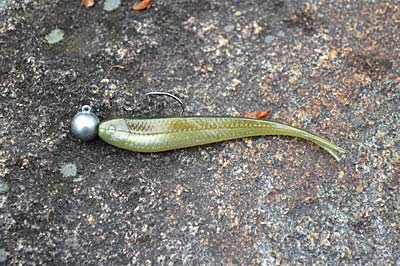
Christie went to work on Lake Tenkiller in his home state of Oklahoma, dedicating plenty of time over five years to develop a solution to his FFS problem. The combination of a jig head and slender soft-plastic minnow proved easy to present to suspended bass, and it caught them, too. So, he tested it at the 2022 Bassmaster Classic on Lake Hartwell, a deep reservoir on the Georgia-South Carolina line filled with plenty of clear water. It proved perfect for catching bass swimming in a 15- to 30-foot deep drain that he could see on his FFS, pushing him to victory.
Christie’s Classic success accelerated work on what’s now known as the YUM FF Sonar Minnow. Warner said that besides its dense lead head, which soundly returns signals to the transducer, nothing in the design or construction makes this lure appear on FFS. Instead, its effectiveness comes from its ability to “float,” allowing it to slowly work at a precise depth in front of suspended bass. That creates a natural presentation and time to coax strikes.
Christie was specific about the design. The round jig head needed a sickle-style hook that helps with straight-line sets and a 90-degree line tie to create the proper presentation. In addition, it's offered in three weights, allowing anglers to compensate for wind, current, and depth.
That attention to detail was focused on the soft-plastic trailer, too. Christie wanted a horizontal forked tail, which helps the FF Sonar Minnow swim at a consistent depth. Its 3-inch length, thin and tapered profile, molded scales, and color patterns work together to perfectly mimic a baitfish, making it irresistible to bass wary by clear water.
Catching suspended bass with the FF Sonar Minnow requires a holistic approach. "We called it a system because it is a system," Warner said. Electronics, boat positioning, retrieving, and tackle must work together seamlessly. Christie demands a 7-foot spinning rod that sports a 4-power and slow to medium action. His reel has a 6.2:1 gear ratio to control his lure's speed and depth precisely. Its spool is filled with 16-pound test braided line, improving sensitivity. It also eliminates the coiling often found in monofilament and fluorocarbon lines, making casting lightweight lures difficult. He adds stealth with a 15-foot leader of 8-pound test fluorocarbon line.
Christie, constantly watching his FFS, casts his FF Sonar Minnow toward the bass he sees, letting it sink to just above them. Then, he starts a slow and steady retrieve, softly shaking his rod tip to make the minnow come alive, quivering, not hopping. Then, holding his rod at a 45-degree angle to the water's surface, he adjusts his retrieve speed to maintain depth.
While the FF Sonar Minnow was perfected on wintertime bass, Christie said it works on summertime suspended bass, too. All you need is relatively clear water and bass swimming off the bottom. “You might catch one of those fish with something else, but with this technique, you can catch all of them,” Christie said.
Bill Lewis SCOPE Stik
Designers at this iconic crankbait company created several models of this unique jerkbait to keep your presentations on target. They cover any depth, look natural, and are easily seen on FFS.
- Length: Two sizes, 100 millimeters, and 120 millimeters
- Weight: Floating, suspending, and sinking models from 3/8 to 5/8 ounce
- Attraction: Diving and darting
- Colors: 12 patterns

Bass suspend in water that’s slightly stained to clear. That allows them to see further than in dirty water, making them more aware of their surroundings. Boat noise, such as pinging electronics, can spook them, even when swimming 20, 30, or more feet deep. So, long casts are vital to catching those you find with FFS. SCOPE Stik is built with that in mind. Its internal transitioning cast-weight moves to the lure's tail during your cast, launching the lure forward, and carrying it further than traditionally weighted jerkbaits.
But getting your bait away from the boat is only half the battle. First, it needs to get down to the bass' level and stay there through as much of the retrieve as possible. The SCOPE Stik, offered in two sizes, is available in six models, including floaters, suspenders, and sinkers. That makes it easy to find one that works through the slice of the water column you’re targeting, from the surface to the bottom.
Once it's down among the bass, the SCOPE Stik’s other characteristics go to work. Its pronounced flat sides, which designers say make the lure pop on FFS, work with its lip to create hard turns and flashes. “The action on this bait is second to none as it jumps left to right, as well as up and down,” Bill Lewis Pro Team member and Major League Fishing and Bass Pro Tour angler Mark Daniels Jr. said when the lure was released. “It’s truly unlike any other jerkbait I’ve ever seen.”
Jewel Bait Scope Spin
Master lure designer Lyndall Helms needed a lure that could reach bass suspended in deep water. So, he started tinkering with a design eight years ago, before FFS was available. The result ended up being perfect for the new technology.
- Length: 2.5 inches
- Weight: 1 ounce
- Attraction: Natural shape and spinning blade
- Colors: Three baitfish patterns
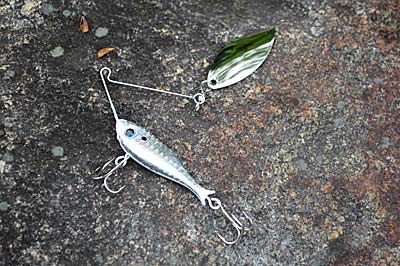
Like other lures designed for FFS, the Scope Spin tries to accomplish several things. First, its relatively heavy weight makes it easy to cast long distances, taking it far from your boat. That also helps it sink quickly — about 2 feet every second — allowing you to count it down to the bass you see on FFS.
The Scope Spin’s shad-shaped lead body is dense, making it easy to see on FFS. It also is balanced, ensuring it runs horizontally. That helps it stay at a consistent depth, whether slightly above or below the bass. But balance doesn’t do it alone. Its spiral blade, which starts turning the instant it hits the water, also contributes to attracting bass.
The Scope Spin is a versatile addition for the Arkansas bait builder widely known for its jigs. Helms said it not only catches bass away from the boat but also catches ones under it. Hook one suspended bass, and the whole is likely to follow it toward your boat, he said. Then, once you see them on your traditional 2-D sonar or down scan, you can use the Scope Spin to jig for them vertically.
More On The Horizon
Bass anglers are innovative, so these lures are only the beginning for FFS-specific designs. Others, including Original Fish Formula's Bait Pop, are already on the market. Apply it to any lure, and it becomes more visible on FFS, according to its maker.
It won’t be long, and other lures designed explicitly for FFS will be catching bass. While some will be built from scratch, others will be current offerings identified by anglers who understand the specific characteristics these lures need.


